► We visit Merc F1’s Northamptonshire HQ
► Boss Toto Wolff gives CAR the guided tour
► Even Lewis needs a pass to step inside
‘It isn’t as smart as the MTC, but it’s more practical; it’s more old school.’
Lewis was comparing old and new on his first day as a Mercedes driver back in January 2013. He was being tactful, but he couldn’t hide a wry smile when highlighting the differences between McLaren’s $450 million, Norman Foster-designed, largely subterranean Technology Centre in Woking and Mercedes’ rather less ostentatious cluster of buildings near Brackley known as the ‘Operations Centre’.
‘The McLaren factory is futuristic,’ he went on, ‘but this place has everything you need to go racing at the front. It’s practical; I fancy our chances of building a good car, which is why I’ve switched teams.’
How right he was: Mercedes have dominated Formula One for the last two years, while McLaren have slipped steadily backwards. Mercedes have epitomised practicality and efficiency from their modest factory; McLaren have looked all show and no go. There are no coy carp or pillarless, glass-fronted buildings at Mercedes Grand Prix in Brackley; the team is all about functionality, of the kind that McLaren boss Ron Dennis must be supremely jealous of at this moment.
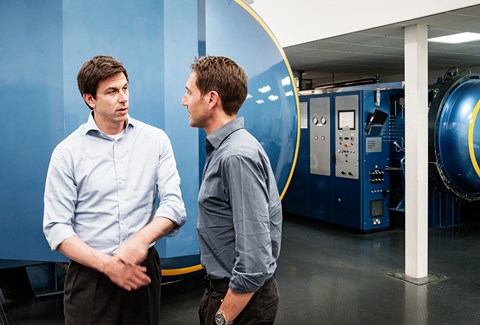
The factory is hidden from view by trees. Anyone driving north up the A43 towards Silverstone would be unaware of its existence, unless they were shopping in Brackley’s out-of-town Tesco. Opposite the supermarket’s main entrance is a mini-roundabout, beyond which lies the 60,000 square metre site of Mercedes GP. As world championship-winning entrances go, this one is low key; the only giveaway sign that something a bit swish is made inside is the large number of Mercs parked in the car park.
Guests have to stop at the gatehouse and give their name and car registration. Only then can they head into the inner sanctum of the team, which – and please take this the right way, Merc people – has the feel of a shopping retail park. A mix of grey buildings, in which Currys PC World wouldn’t look out of place, hems in the car park. Instead, however, the buildings are home to facilities such as the paint shop and the wind tunnel of the best team in F1.
The distance between the buildings is small, but if tech boss Paddy Lowe is doing his departmental rounds on a rainy day, he’s still going to get wet. It’s very un-McLaren, where Paddy worked for 20 years prior to joining Mercedes in 2013.
‘It’s a bit different to McLaren,’ he says, ‘but I’m very happy with our facilities here. It’s all totally cutting edge. Actually, I like the layout because it means I get to take a bit of exercise during my working day!’
The walk from the visitors’ car park to reception takes you past the directors’ parking bays. They drive Mercs, as you’d expect – it’s all AMG GTs and S65 AMGs – and the cars are all reversed into their parking spots. No OCD here then. Glass doors invite people into the reception area, the décor for which can best be described as Stuttgart chic: art deco chairs, immaculate wooden surfaces and an eclectic mix of pictures.
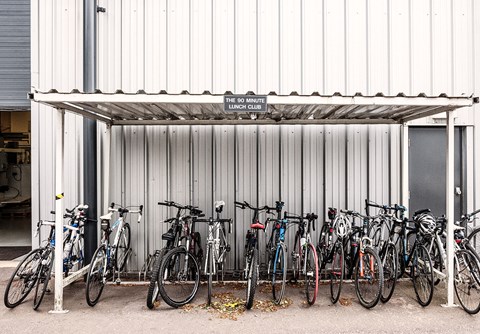
The team’s ever-expanding trophy cabinet sits on the left and taking pride of place, just to the right of centre, is Hamilton’s title-winning W05 F1 car. It’s the actual chassis in which he won his second world championship at last year’s Abu Dhabi Grand Prix, stone chips ‘n’ all. To get deeper into the factory, everyone – even Lewis, so we’re told – needs a pass. The receptionist dials up Toto Wolff to inform him that CAR is in the building and while we wait for the team boss’s arrival, we spend more time looking around reception. There’s a huge pile of chocolates in the corner, a fresh delivery from sponsor UBS, who give all 700 employees a box of chocs after each race win. Last Sunday’s win at Monza was number 10 for the season. 7000 boxes of chocolates? It’s amazing the team doesn’t have a collective weight problem!
The trophy cabinet is rammed with reminders of podium positions won in the last four years, but there’s one incongruous silver salver that has nothing to do with F1. It was awarded to Mercedes after its victory in the Brackley Soapbox Derby this summer and highlights how much the team gets involved in the local community, above and beyond being the area’s biggest employer. When you consider the factory is also carbon neutral, you begin to appreciate why Mercedes GP is held in such high esteem by the county council.
It’s while we’re perusing this trophy that Toto Wolff arrives. The 43-year-old Austrian is team principal and a 40% shareholder in Mercedes GP. His business card also carries the title Executive Director of Mercedes-Benz Motorsport, which means he oversees all of Merc’s racing activities, from F1 to DTM, sportscars and Formula 3.
‘Don’t get lost in job titles,’ he says. ‘Ninety percent of my time is spent on F1; it’s my main focus.’
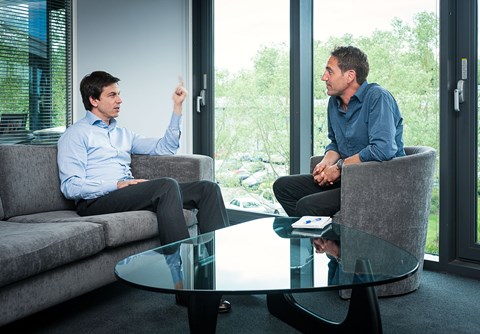
I’ve known Toto since 2009, when he bought shares in Williams F1, but the firmness of his handshake still surprises. He looks you in the eye and smiles as he says hello in his clipped Austro-English accent. He then flashes his ‘access-all-areas’ card and we enter the factory proper.
This pass system is another difference between Mercedes and its main rivals. Red Bull Racing, for example, have adopted a fingerprint system to access different parts of their Milton Keynes factory, but Mercedes continue to use the pass system that was used by British American Racing, when they built the factory back in 1997.
The link to BAR is a reminder of how much F1 has moved on in the last 15 years. In the mid-’90s BAR were considered cutting-edge and F1’s more unkind pontificators guffawed at the decadence of their factory. A lot of people got pleasure from the fact that BAR never won a race. Nowadays, the factory is considered functional rather than extravagant.
Toto’s office lies on the first floor, adjacent to the marketing office. That’s significant because it immediately helps to define the job split between him and tech boss Lowe. In short, Paddy looks after the car while Toto oversees everything else, which is predominantly politics and marketing. Hence his juxtaposition to the team’s marketeers.
The coffee flows freely and Toto explains how he came to lead the dominant F1 team of the moment. ‘Mercedes wanted what they called a managing partner,’ he says. ‘They wanted someone involved who had skin in the game – a shareholding – and they were quick to remind me that I was now representing one of the best brands in the world.’
Over the course of our chat, and the subsequent tour he gives us around the factory, Toto’s management style becomes clear. He’s open with everyone, whatever their job title, and he’s friendly and enthusiastic. ‘I’m a sparring partner, a coach and a friend,’ is how he describes his relationship with other team members. ‘I have a very long-term strategic perspective; I try to put things in place three years ahead of time.’
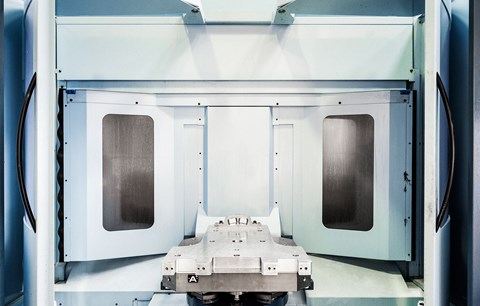
He is quick to praise the contribution of his predecessor Ross Brawn. The Englishman left the team at the end of 2013, a matter of weeks before Mercedes unleashed their current stranglehold on F1. There’s no doubt that Ross laid the foundations for the team’s current success, and Toto knows that.
‘Ross did a tremendous amount of work to get us where we are today,’ he says. ‘It’s now up to Paddy and me to maintain our advantage and to take things forward. My biggest fear is of losing our current advantage.’
It was to protect the team’s winning edge that Toto turned down Red Bull when they asked for a supply of Mercedes engines in 2016. ‘The disadvantages outweighed the advantages,’ he says. ‘I’m always proposing ideas for the good of F1, but I won’t agree to anything that will compromise my team. That’s not what I’m paid to do.’ We move from Toto’s office to the design office, which is a massive open-plan room that’s home to some of the best automotive brains in the world. To get there, we pass through a couple of doors that require more pass authorisation and we stop briefly to marvel at some wall-sized photographs of 1950s Silver Arrows.
At one end of the design office, which is known colloquially as the ‘DO’, is the Remote Pit Garage. It’s here that the race engineers base themselves between races and, when they’re away racing, a fresh group of engineers and strategists move in to back-up their efforts. These factory-based engineers can talk to the pitwall in real time, contributing to every aspect of strategy and car set-up.
There is every possible timing screen on the wall, plus a cinema-sized TV. There’s no F1 taking place on the day of our visit, so the screens are tuned in to practice at a World Endurance Championship race in Germany. Clearly, these guys are true racing nuts; they aren’t boffins who stumbled into racing for want of something better to do.
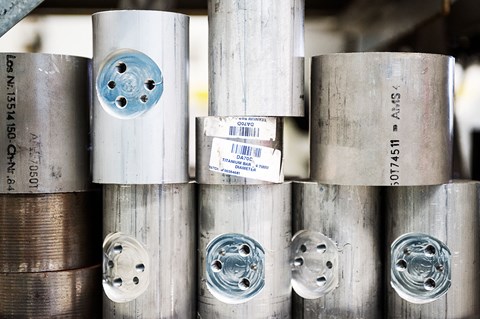
The design office itself is divided into areas of the car; the gearbox designers all sit together, for example. Situated in a separate wing, but still in an open-plan format, are the heads of department – guys like Aldo Costa (engineering director), Geoff Willis (technology director), Mark Ellis (performance director) etc. ‘You have to be really brainy to sit over here,’ says Toto, ‘which is why my office is so far away!’
Toto is of course being modest because a more impressive CV would be hard to find in F1. He was educated at the Lycee Francaise in Vienna where, among other things, he played a lot of rugby. His entrepreneurial spirit shone through from an early age, when he sold candles at a protest march against Jorg Haider, a far-right Austrian politician, and he went on to sell steel for ring binders, which proved successful enough to finance a promising racing career.
However, he proved to be a better entrepreneur than racing driver and a massive shunt on the Nurburgring’s Nordschleife resulted in him focusing on his business interests. His F1 involvement began in 2009, when he bought a minor shareholding in Williams, and he quickly expanded his portfolio to include the management of Valtteri Bottas. Then came the opportunity with Mercedes a couple of years ago.
‘A racing team is different to the other businesses I’ve owned,’ he says. ‘We have to prove ourselves 20 times a year, not four times a year like in a public company. It’s very fast paced.
‘We work hard to keep the right people in the right jobs. We have an HR system that filters the high performers from the ones we consider to be neutral or inconsistent and it flags up when someone’s contract is going to run out so we can work on renewing it.’
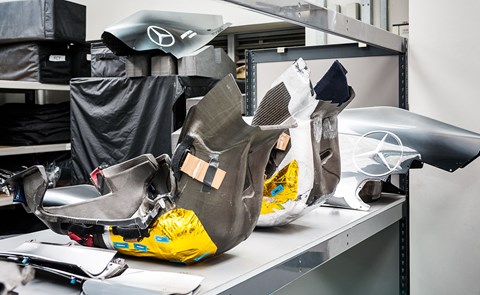
More than 250,000 man hours go into the design of an F1 car. At any one moment the design team will be working on three different projects: the current car, the one for the following year and the one two years down the road. It’s a manifestation of Toto’s three-year policy and the amount of resource attributed to each project varies according to the stage of the cycle.
From the design office, Toto leads us downstairs to the race bays and to some of the main production areas. It’s here that more than 200,000 man hours are ploughed into getting two cars on the grid. Such is the intensity of the F1 schedule that the lights never go out, except during the enforced two-week F1 summer shutdown and on Christmas Day.
There are five race bays and it’s here where the cars return after each race to be stripped and re-built. Parts are lifed and replaced when necessary, and the whole turnaround takes three days, although it can be done significantly quicker when there are back-to-back races.
Each bay is surprisingly small; there’s room for only one chassis and the mechanics have to be tidy in their work. It’s incredibly well lit and there are portable spot lamps to help with those recessed parts caught in the shadows. At one end there’s a white board, where the number one mechanic writes notes about the work that’s taking place and the rest of the guys write their tea orders.
It’s also in the race bays that the entire team gathers at 2pm on the Monday after each race to receive a debrief from either Toto or Paddy, or sometimes both. They give a warts ’n’ all appraisal of the weekend’s work and sparkling wine is served if the team has won. Above the race bays is eBay heaven. A mezzanine floor houses old parts from previous cars – floors, rear wings, engine covers, suspension components – and it’s the only scruffy area in the entire factory. Someone no doubt knows what all of the parts are, and which chassis they come from, but it’s not immediately obvious to the untrained eye.
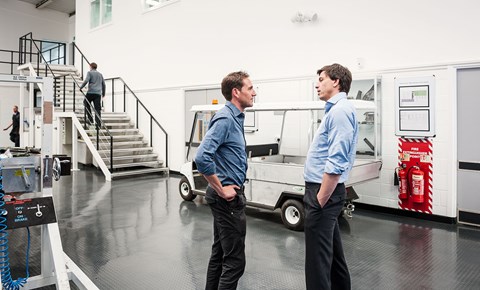
‘It’s a brief history of the team up there,’ shouts one of the lads. ‘Worth a few quid.’
Next door is the composites department. The contrast with the spares area is extreme: you could eat your lunch off any of the immaculate surfaces and people wearing plastic overalls are bent over double, layering carbon with the precision of plastic surgeons. They’re working on a new chassis in one room and what looks like various suspension components in another. We’re allowed in neither area because dirt and dust compromise the bonding process, but it’s still impressive through the window.
Toto then takes us on a whistle-stop tour of the giant ovens, where the carbon parts are cooked, and he then shows us a new €3 million CNC machine, which is used for manufacturing gearbox parts. It’s sophisticated, although the A4 ring binders being carried around by staff are proof that pen and paper still has a place in this high-tech world.
We cross the car park to enter the paint shop, which doesn’t need much explanation here. The spray techniques are elaborate and thorough, and a lot of research goes into new lightweight paints. Another point of note is that the bigger sponsor decals aren’t stickers; the logos are painted onto the bodywork to improve the airflow over the car. No rough edges permitted.
The wind tunnel is in another nondescript building. If we showed you photos of the 60% model being tested we’d have to kill you, but believe us when we say the level of detail is second to none. It’s everything you’d expect of a tunnel that was modernised in 2012, making it one of the most up-to-date in F1.
But that’s the thing about this factory: everywhere you go, you have to dig beneath the slightly bland exterior to discover its gems, of which there are many. There’s no showing off; the money here is spent on performance. The design office, the wind tunnel, the production areas, all are fertile breeding grounds for ideas. They reflect the no-nonsense, entrepreneurial spirit that permeates from the man at the top. Brackley is in fine fettle, then. Just as well, as there is always Maranello.
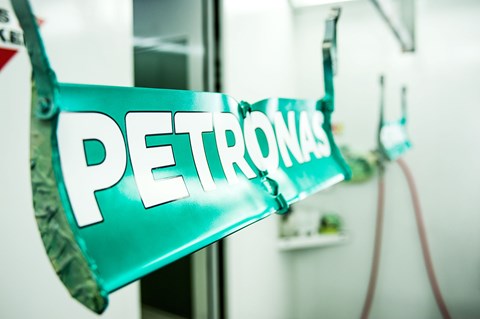
Brackley HQ: a quick history
The Brackley factory was built by British American Tobacco in 1997 as the operations centre for its F1 team, British American Racing (remember them? Jacques Villeneuve, bizarre double livery etc?). The team promised to win its first GP in 1999, but it failed spectacularly, scoring not a single point in the entire season. It continued to underperform until it was sold to Honda in 2006.
Despite the efforts of Jenson Button, more lacklustre seasons followed, and Honda bailed from F1 at the end of 2008. The 700 staff at Brackley continued to work on the next car while a buyer was sought, and after an uncertain winter team principal Ross Brawn came to the rescue with a management buy-out. Brawn GP brought the world championship to Brackley in 2009, winning eight races, leading to interest from Mercedes, who bought the team in 2010.
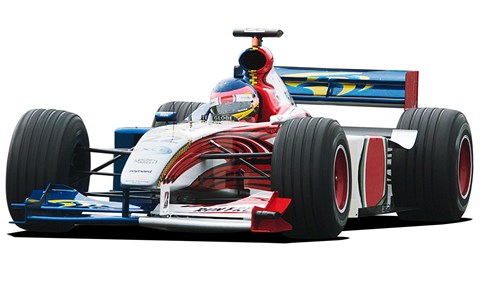
Lewis’s car: Made in Brackley!
There are more than 10,000 parts in an F1 car, split 60:40 between chassis and power unit. In the case of Mercedes Grand Prix, the power unit is produced at Mercedes High Performance Engines, just 27 miles away in Brixworth, which leaves just the chassis to be manufactured in Brackley. The chassis is designed in-house and more than 80% of it is built there too, including all of the carbon composite parts. Only the more exotic materials out-sourced to specialist companies. All of the painting is done at Brackley. Once four chassis have been produced at the start of a season, most of the factory is dedicated to making spare parts. Such is the price of a reliability failure, both literally and in terms of points, that parts are lifed very conservatively.